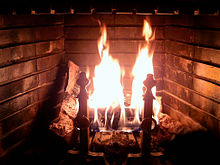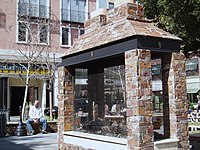Fireplace
This article needs additional citations for verification. (May 2008) |
A fireplace is an architectural structure designed to contain a fire for heating, as well as for cooking. Fireplaces are also used for the relaxing ambiance they create. A fire is contained in a firebox or firepit; a chimney or other flue allows exhaust to escape. A fireplace may have: a foundation, a hearth, a firebox, a mantel, an ashdump door, a chimney crane, a cleanout door, a grate, a lintel, a lintel bar, overmantel, a chimney breast, a damper, a smoke chamber, a throat, a flue, a chimney chase, a crown, a cap, a shroud, or a spark arrestor.
Fireplaces have variable heat efficiency. Organizations like the Environmental Protection Agency and the Washington Department of Ecology warn that, according to various studies, fireplaces can pose a significant health risk.[1][2] The EPA writes "Smoke may smell good, but it's not good for you."[1]

Types of fireplaces
- Masonry fireplaces are made from brick or stone.
- Manufactured fireplaces are made with sheet metal fire boxes.
Masonry and prefabricated fireplaces can be fueled with wood, natural gas, biomass and propane fuel sources. Ventless Fireplaces (duct free/room-venting fireplaces) are fueled by either gel, liquid propane, bottled gas or natural gas. In the US, some states and local counties have laws restricting these types of fireplaces. They must be sized appropriately to the area to be heated. There are also air quality control issues due to the amount of moisture they release into the room air, and oxygen sensor and carbon monoxide sensors are safety essentials.
Chimney and flue types:
- Masonry (brick or stone fireplaces and chimneys) with or without tile-lined flue.
- Reinforced concrete chimneys. Fundamental design flaws bankrupted the US manufacturers and made the design obsolete. These chimneys often show vertical cracks on the exterior.
- Metal-lined flue: Double or triple walled metal pipe running up inside a new or existing wood-framed or masonry chase.
Newly constructed flues may feature a chase cover, a cap, and a spark arrestor at the top to keep small animals out and sparks from exiting the chimney cavity.
Accessories

A wide range of accessories are used with fireplaces, which vary between countries and regions, and historical periods. For the interior, common in recent Western cultures are grates, fireguards, logboxes, andirons, pellet baskets, and fire dogs, all of which cradle fuel and accelerate burning. Heavy metal firebacks are sometimes used to capture and reradiate heat, to protect the back of the fireplace, and as decoration. For fireplace tending, tools include pokers, bellows, tongs, shovels, brushes and toolstands.

History

Ancient fire pits were sometimes built in the ground, within caves, or in the center of a hut or dwelling. Evidence of prehistoric, man-made fires exists on all five continents. Chimneys, invented much later, partially fixed this problem, venting smoke outside.
In 1678 Prince Rupert, nephew of Charles I, raised the grate of the fireplace, improving the airflow and venting system. The 18th century saw two important developments in the history of fireplaces. Ben Franklin developed a convection chamber for the fireplace that greatly improved the efficiency of fireplaces and wood stoves. He also improved the airflow by pulling air from a basement and venting out a longer area at the top. In the later 18th century, Count Rumford designed a fireplace with a tall, shallow firebox that was better at drawing the smoke up and out of the building. The shallow design also improved greatly the amount of radiant heat projected into the room. Rumford's design is the foundation for modern fireplaces.
Evolution of fireplace design
Over time the design of fireplaces has changed from one of necessity to one of visual interest. Early ones were more fire pits than modern fireplaces. They were used for warmth on cold days and nights, as well as for cooking. They also served as a gathering place within the home. These fire pits were usually centered within a room, allowing more people to gather around it.
Many flaws were found in early fireplace designs. Along with the industrial revolution came large scale housing developments, obviating a standardization of fireplaces. The most renowned fireplace designers of this time were the Adam Brothers. They perfected a style of fireplace design that was used for generations. It was smaller, more brightly lit, with an emphasis on the quality of the materials used in their construction, instead of their size.
By the 1800’s most new fireplaces were made up of two parts, the surround and the insert. The surround consisted of the mantlepiece and sides supports, usually in wood, marble or granite. The insert was where the fire burned, and was constructed of cast iron often backed with decorative tiles. As well as providing heat, the fireplaces of the Victorian era were thought to add a cozy ambiance to homes.[3]
Heating efficiency
Some fireplace units incorporate a blower which transfers more of the fireplace's heat to the air via convection, resulting in a more evenly heated space and a lower heating load. Fireplace efficiency can also be increased with the use of a fireback, a piece of metal that sits behind the fire and reflects heat back into the room. Firebacks are traditionally made from cast iron, but are also made from stainless steel.[4]
The most effective fireplaces in terms of heating efficiency are modern, wood-burning masonry fireplaces. Modern masonry fireplaces are often equipped with a large fire window, enabling an efficient heating process in two phases. During the first phase the initial heat is provided through a large glass window while the fire is burning. During this time the structure, built of refractory bricks, absorbs the heat. This heat is then evenly radiated for many hours during the second phase. Masonry fireplaces without a glass fire window only provide heat radiated from its surface. Depending on outside temperatures 1 to 2 daily firings are sufficient to ensure a constant room temperature.
Health effects
In a literature review published in the journal of Toxicology and Environmental Health, J.T. Zelikoff concludes that there are a wide variety of health risks posed by residential wood combustion. She writes:
With regard to adults, studies show that prolonged inhalation of wood smoke contributed to chronic bronchitis, chronic interstitial lung disease, pulmonary arterial hypertension and corpulmonale, and altered pulmonary immune defense mechanisms. While adverse effects on adults are notable, children appear to be at greatest risk. Many studies that focused specifically on RWC [Residential Wood Compbustion] have concluded that young children living in homes heated by a wood-burning stove had a greater occurrence of moderate and severe chronic respiratory symptoms than children of the same age and sex who did not live in homes heated with a wood burning stove. Exposure of preschool children living in homes heated with wood burning stoves or in houses with open fireplaces yielded these effects: decreased pulmonary lung function in young asthmatics; increased incidence of acute bronchitis and severity/frequency of wheezing and coughing; and increased incidence, duration, and possibly severity of acute respiratory infections.
Residential wood combustion emissions also contain sulfur oxides, nitrogen oxides, carbon monoxide and potentially carcinogenic compounds including polycyclic aromatic hydrocarbons, benzene, formaldehyde and dioxins. Some of these pollutants are known to cause cancer but their effects on human health via exposure to wood smoke have not been
extensively studied.[5]
The Washington Department of Ecology also published a booklet explaining why wood smoke can be dangerous. It explains that human lung and respiratory systems cannot filter the particles emitted by wood combustion, which penetrate deeply into the lungs. For months, cancer causing chemicals can continue to cause changes and structural damage within the respiratory system. Young children, seniors, pregnant women, smokers and individuals with respiratory disorders are most vulnerable. Wood smoke can cause disease and even death in children because it is associated with lower respiratory tract infections.[2] The Families for Clean Air (FCA) organization is a charity that seeks to spread awareness of dangers of wood smoke - partly by collecting studies and other resources.
References
- ^ a b EPA, "BurnWise: Consumers - health effects", epa.gov, Retrieved March 3.
- ^ a b Washington's Department of Ecology, "Health Effects of Wood Smoke", 1997, Retrieved February 3 2012
- ^ http://www.fireplaceantiques.co.uk/Category/history-of-the-antique-fireplace/865
- ^ "Three Steps to a More Efficient Fireplace".
- ^ Zelikoff, J.T., 2002. The Toxicology of Inhaled Woodsmoke. Journal of Toxicology & Environmental Health, Part B, 5:269-282
